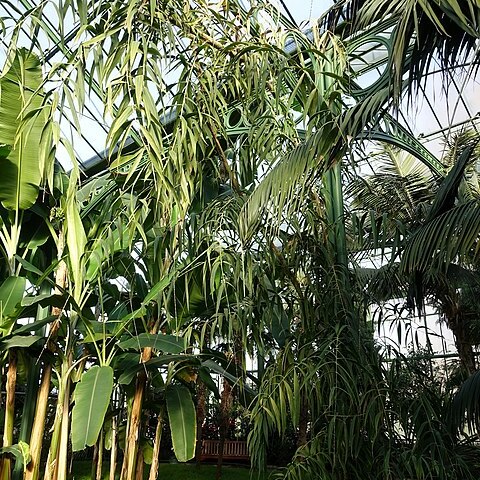Stems clustered, to 20 m, 5-10 cm in diam. Leaf sheaths green, densely covered initially with whitish brown tomentum, with brown, needlelike spines to 2.5 cm borne in rows almost circling sheath; petioles 6-15 cm; rachis to 1.5 m; pinnae to 30 per side of rachis, lanceolate, with an elongate, filiform apex, without prominent mid-and submarginal veins, minutely spiny along margins, irregularly arranged in clusters of 2 or 3 pinnae, spreading in different planes, green abaxially; middle pinnae 25-50 cm, 2-4 cm wide at mid-point; cirri to 1 m. Inflorescences several per stem, branched to 2 orders, with several pendulous primary branches, these 40-80 cm; rachillae subtended by prominent, ± rectangular bracts to 5.5 × 2 cm, densely tomentose adaxially with brown, feltlike scales; male flowers with 6 stamens; female flowers with stigmas to 1 mm. Fruits globose, 1-1.5 cm in diam.; fruit scales fringed, without bristly, erect apices.
More
A rattan. It grows in clusters. The stems are 20 m long by 5-10 cm wide. The leaf sheaths are green and covered with white hairs. There are brown needle like spines 2.5 cm long. The leafy stalk i 1.5 m long and has 30 leaflets on each side. They are sword shaped with a fine tip. There are small spines along the edge. The leaflets are irregularly arranged in clusters of 2 or 3 and are spread in different planes.
Mostly found in middle and upper warm, moist, broad-leaved hill forest; often in degraded or disturbed areas with relatively high light exposure such as gullies or gaps formed by tree-falls or landslides.
More
It is a tropical and subtropical plant. It grows in mountain rain forests between 1,500-2,500 m above sea level in southern China. In Yunnan.


